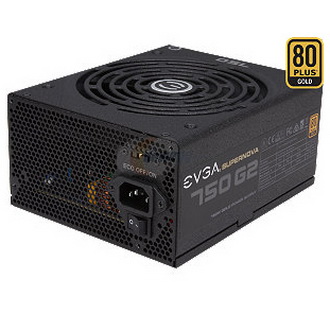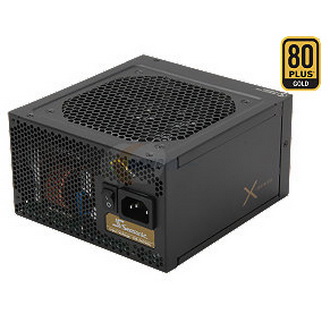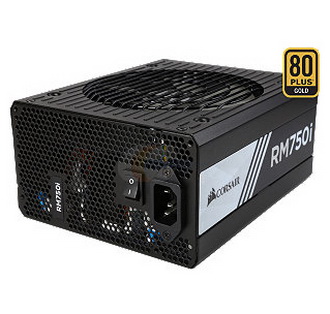Corsair RM750x PSU Review
Corsair released its RMx PSU line, which the company claims will offer good performance along with silent operation. Unlike the RMi models, the RMx units lack a digital interface, a fan test button, and uses a Rifle bearing fan instead of an FDB version.
Why you can trust Tom's Hardware
Load Regulation, Hold-Up Time And Inrush Current
To learn more about our PSU tests and methodology, please check out How We Test Power Supply Units.
Primary Rails And 5VSB Load Regulation
Load Regulation testing is detailed here.
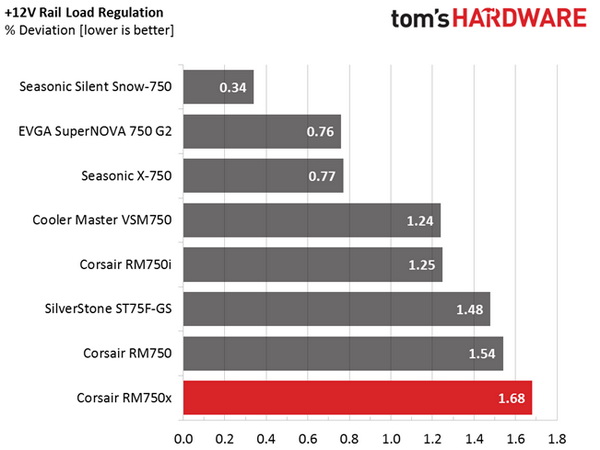
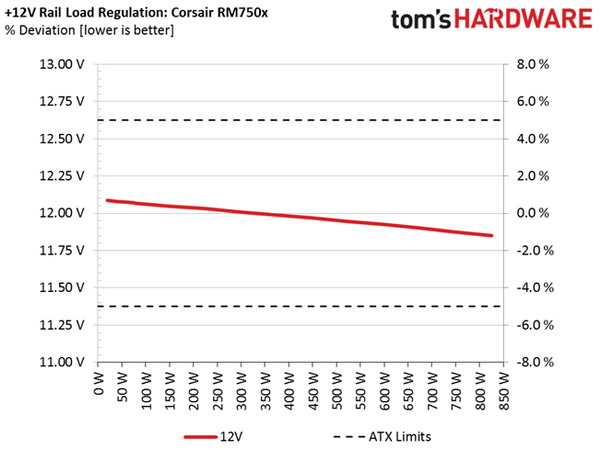



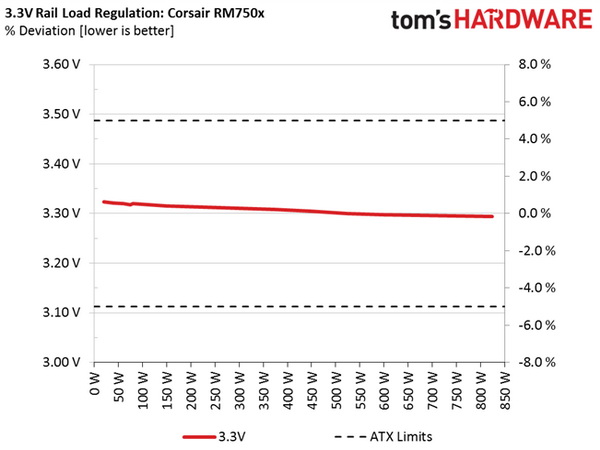
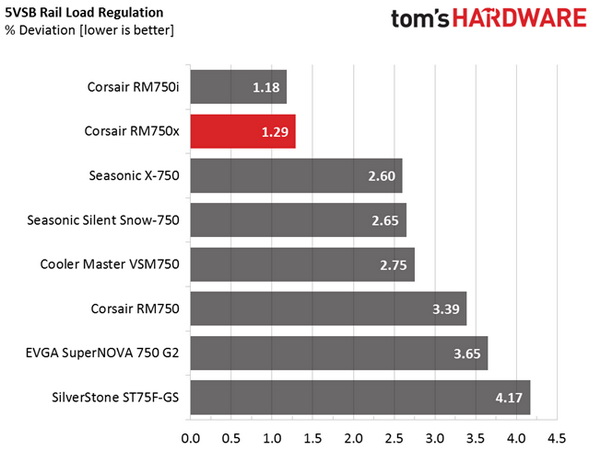
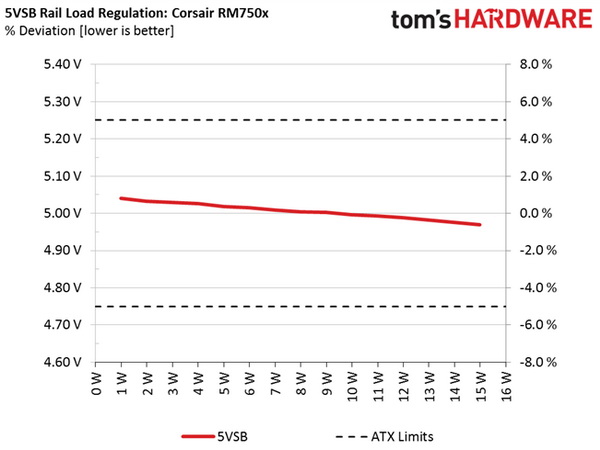
Hold-Up Time
Our hold-up time tests are described in detail here.

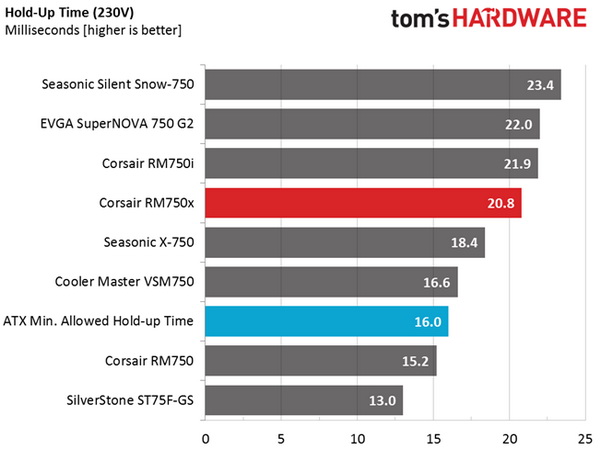
The registered hold-up time was very high. A small difference gave the Corsair RM750i the lead here, however.
Inrush Current
For details on our inrush current testing, please click here.
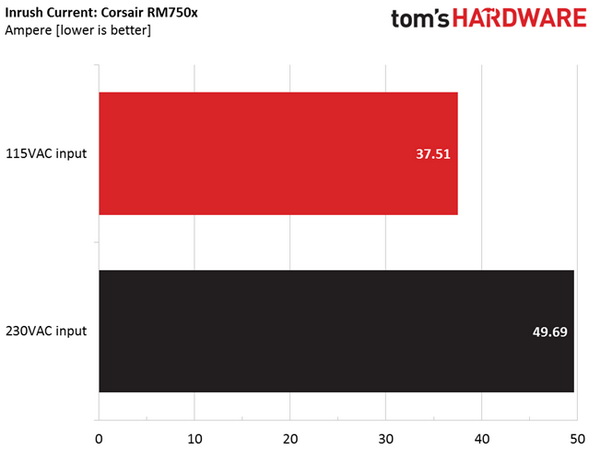

Our power analyzer showed a quite high inrush current reading of 230V. This shouldn't trouble you, however, since inrush current stayed below 50A in any case.
Load Regulation And Efficiency Measurements
The first set of tests reveals the stability of the voltage rails and the PSU's efficiency. The applied load equals (approximately) 10 to 110 percent of the maximum load the supply can handle, in increments of 10 percentage points.
Get Tom's Hardware's best news and in-depth reviews, straight to your inbox.
We conducted two additional tests. During the first, we stressed the two minor rails (5V and 3.3V) with a high load, while the load at +12V was only 0.10A. This test reveals whether a PSU is Haswell-ready or not. In the second test, we determined the maximum load the +12V rail could handle with minimal load on the minor rails.
| Test | 12V | 5V | 3.3V | 5VSB | Power(DC/AC) | Efficiency | Fan Speed | Fan Noise | Temp(In/Out) | PF/AC Volts |
|---|---|---|---|---|---|---|---|---|---|---|
| 10 | 4.403A | 1.985A | 1.988A | 0.995A | 74.74W | 85.47% | 0 RPM | 0 dBA | 49.36°C | 0.967 |
| 12.070V | 5.042V | 3.318V | 5.018V | 87.45W | 42.08°C | 115.1V | ||||
| 20 | 9.863A | 2.970A | 2.984A | 1.195A | 149.70W | 89.33% | 0 RPM | 0 dBA | 51.19°C | 0.988 |
| 12.049V | 5.042V | 3.315V | 5.015V | 167.59W | 43.03°C | 115.1V | ||||
| 30 | 15.690A | 3.475A | 3.499A | 1.395A | 224.85W | 90.45% | 0 RPM | 0 dBA | 51.94°C | 0.993 |
| 12.030V | 5.042V | 3.313V | 5.009V | 248.58W | 43.17°C | 115.1V | ||||
| 40 | 21.530A | 3.963A | 3.984A | 1.595A | 299.70W | 90.63% | 0 RPM | 0 dBA | 54.64°C | 0.995 |
| 12.009V | 5.040V | 3.311V | 5.004V | 330.70W | 43.80°C | 115.1V | ||||
| 50 | 27.043A | 4.963A | 4.983A | 1.797A | 374.71W | 90.36% | 0 RPM | 0 dBA | 58.11°C | 0.997 |
| 11.989V | 5.041V | 3.308V | 5.002V | 414.71W | 45.61°C | 115.1V | ||||
| 60 | 32.575A | 5.951A | 5.990A | 2.000A | 449.63W | 89.83% | 615 RPM | 25.2 dBA | 45.38°C | 0.997 |
| 11.968V | 5.039V | 3.305V | 4.996V | 500.53W | 64.21°C | 115.1V | ||||
| 70 | 38.130A | 6.947A | 6.997A | 2.199A | 524.57W | 89.24% | 680 RPM | 27.1 dBA | 45.93°C | 0.997 |
| 11.946V | 5.038V | 3.300V | 4.993V | 587.83W | 66.01°C | 115.1V | ||||
| 80 | 43.712A | 7.940A | 8.005A | 2.404A | 599.59W | 88.57% | 820 RPM | 30.9 dBA | 47.67°C | 0.997 |
| 11.924V | 5.036V | 3.297V | 4.988V | 676.95W | 68.02°C | 115.1V | ||||
| 90 | 49.751A | 8.445A | 8.524A | 2.402A | 674.63W | 87.86% | 915 RPM | 34.9 dBA | 47.90°C | 0.998 |
| 11.900V | 5.035V | 3.296V | 4.988V | 767.82W | 68.70°C | 115.1V | ||||
| 10 | 55.549A | 8.941A | 9.012A | 3.015A | 749.39W | 87.03% | 1075 RPM | 38.0 dBA | 48.71°C | 0.998 |
| 11.876V | 5.034V | 3.295V | 4.970V | 861.09W | 70.78°C | 115.1V | ||||
| 11 | 61.992A | 8.946A | 9.017A | 3.015A | 824.36W | 86.11% | 1190 RPM | 40.5 dBA | 49.48°C | 0.998 |
| 11.851V | 5.031V | 3.294V | 4.969V | 957.30W | 72.38°C | 115.1V | ||||
| CL1 | 0.098A | 18.024A | 18.003A | 0.004A | 152.42W | 82.11% | 765 RPM | 29.4 dBA | 46.16°C | 0.990 |
| 12.039V | 5.074V | 3.320V | 5.116V | 185.62W | 60.06°C | 115.1V | ||||
| CL2 | 62.453A | 1.002A | 1.003A | 1.002A | 754.98W | 87.59% | 1090 RPM | 38.2 dBA | 47.43°C | 0.998 |
| 11.875V | 5.022V | 3.301V | 4.999V | 861.99W | 67.99°C | 115.1V |
At +12V load regulation was decent; however, it didn't manage to meet the competition. We probably pushed the PSU too hard, since at full load the ambient inside the hot box reached 49 C, while we usually stay below 46 C. We wanted to see how loud the unit's fan could be under extremely tough conditions, however, and also verify Corsair's claim about the 50 C rating of this unit. Judging from our overload test, which was conducted at a temperature close to 50 C, the RM750x proved that it has no problem at all operating under extremely tough conditions, delivering its full load for prolonged periods. In addition, thanks to the silent fan and the optimized fan profile, the noise output of this PSU is at very low levels. On top of that, the PSU didn't engage its fan with up to 50 percent load and with an ambient of almost 46 C.
The minor rails, especially the 5V one, managed to keep their deviations low by utilizing the extra voltage sense wires of the Type 4 cables that equip the PSU. And it seems that the increased operating temperatures didn't affect the performance of the DC-DC converters. Finally, the PSU cleared all requirements of the 80 Plus Gold certification. With 100 percent load, it was a close shot, however. As we have mentioned so many times in past reviews, the 80 Plus organization conducts all testing at only 23 C, while we conduct our tests at much higher temperatures, seeking to push the PSUs to their limits. If you want to check performance at lower ambient temperatures (around 28 C), you can take a look at our Cross-load tests on page six, during which we dial (automatically) thousands of possible load combinations.
Current page: Load Regulation, Hold-Up Time And Inrush Current
Prev Page A Look Inside And Component Analysis Next Page Efficiency, Temperature, Noise, Cross-Load Tests And Infrared Images
Aris Mpitziopoulos is a contributing editor at Tom's Hardware, covering PSUs.
-
Blueberries I've been promoting these for a while, it's nice to see Tom's do an article on them. The only reason these are Gold rated is because they just miss the Platinum rating at 20%.Reply
They have a 650x as well that's a little cheaper. -
Amdlova High Rate Faliure can be the the name of this series of corsair. for Now EVGA or SEASONIC power supplies. don't spend a penny on corsair products...Reply -
Aris_Mp Please keep in mind that some Corsair PSUs are also made by Seasonic. Also this series is very new to have a high rate of failures. Unless you have some solid facts to share on the older RM line which is out for quite some time now.Reply -
jonnyguru Reply16801974 said:High Rate Faliure can be the the name of this series of corsair. for Now EVGA or SEASONIC power supplies. don't spend a penny on corsair products...
Wrong on so many levels.
YOU do not have the failure rate for this or any other Corsair PSU.
This PSU is the RMx, not the RM, so even if you did have a failure rate, it would only be about two weeks of data.
If you were talking about the RM and not the RMx, and you actually had failure rate data, you would see that the failure rate on the RM wasn't really high at all.
-
PureBlackFire ReplyHigh Rate Faliure can be the the name of this series of corsair. for Now EVGA or SEASONIC power supplies. don't spend a penny on corsair products...
*sigh* nonsense comment of the day.
-
chalabam Tomshardware:Reply
I don't know if this is a problem of your site, or my PC/IP, but frequently the charts do not load, even when the page "ends" loading.
Sometimes, if I "reload", then the charts also load.
I open all the article pages simultaneously, on different tabs, so I don't need to wait for each one to load. -
Rookie_MIB The older RM units weren't 'bad' really, they were ok, but Corsair has been stepping up its game with quality parts and build on some of these newer units which is nice to see. You can never have too many solidly designed units to choose from - competition toughens the breed.Reply -
Blueberries ReplyHigh Rate Faliure can be the the name of this series of corsair. for Now EVGA or SEASONIC power supplies. don't spend a penny on corsair products...
Did you even LOOK at the article? The only problem with these are the Sinopowers on the secondary side, and that's not even a "bad" thing. Oh and btw, some of the best power supplies in the world are Superflower OEMs produced by Corsair. -
mavikt With these in depth coverage of PSU's I propose introducing a tier'ing table thing at the and of each review (or perhaps a best buy PSU of the month) equivalent to what's done for CPU's and GPU's, ranking PSU models (perhaps too the makers). I saw a comment here on toms on another PSU news flash in the comment section referring to such thing in the forum but now I can't find it.Reply
Permanent'ing such thing from the editorial side would be great! -
Reply
High Rate Faliure can be the the name of this series of corsair. for Now EVGA or SEASONIC power supplies. don't spend a penny on corsair products...
Did you even LOOK at the article? The only problem with these are the Sinopowers on the secondary side, and that's not even a "bad" thing. Oh and btw, some of the best power supplies in the world are Superflower OEMs produced by Corsair.
Corsair doesn't use SuperFlower anywhere in its lineup. CWT, Great Wall, Flextronics, Seasonic and Chicony which has since been dropped are all the OEMs Corsair uses or has used.
